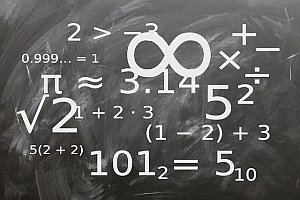Factor Trinomial Calculator
Instructions: Use this trinomial calculator to factor any trinomial you provide, of the form \(a x^2 + bx + c\), showing all the steps. Please type trinomial you want to factor.
Factoring Trinomials
This calculator will allow you factor trinomials of the form \(ax^2+bx+c\). Notice that this is a very specific type of trinomial that essentially corresponds to a quadratic expression.
Once you have provided a valid trinomial, you will need to click , all you need to do is to click on the "Calculate" button, and you will be provided with all the steps of the calculations.
The problem of factoring trinomials is a relatively simple problem, which ultimately relies upon our ability of solving quadratic equations, at least for the type of trinomials we are dealing with.

What is a Trinomial
A trinomial, as the "tri" part indicates, is an algebraic expression with three terms. Technically, something like \(a+b+c\) is a trinomial, all the same as \(a\cdot b\cdot \ c\). But it is usually the case that we mean an additive trinomial, so the latter would not fall in the category.
But furthermore, we implicitly mean a trinomial to have with polynomial terms of the form \(d x^k\). The last assumption we will do is that the highest power is greater by two, we can factor out a term so that the highest power is 2 (this is always possible with sequential powers).
Then, the trionomials we are dealing with are simply reduced to the class of expressions of the form
\[ a x^2 + bx^2 + c \]What are the steps for factoring trinomials?
- Step 1: Identify the trinomial, and make sure it meets the requirements to be a trinomial in the sense of the definition above
- Step 2: Assuming the highest degree is 2, the term is of the form \(a x^2 + bx^2 + c \), so then identify the coefficients a, b, and c
- Step 3: Solve the quadratic equation \\(a x^2 + bx^2 + c = 0\\). Assume that \(\alpha\) and \(\beta\) are the roots, then the trinomial factoring is \(a(x-\alpha)(x-\beta)\)
- Step 4: If the highest degree is larger than 2, factor out the highest power you can, and come back to Step 2
Ultimately, the solution to the task of factoring a trinomial lies upon your ability of factoring terms out and solve quadratic equations.
Can we have common factor of trinomials?
Based on our definition of the trinomials we want to accept for this procedure, technically yes, we can have a common factor, which can be factored out. Indeed, in this calculator the trinomial is assumed to be of the form \(a x^2 + bx + c\), which does not have common factors in general.
But then, you can argue that \(a x^4 + bx^3 + cx^2\) is a trinomial that has common factors, and you'd be correct in saying so.
What happens is that if we can factor out a common factor like \(a x^4 + bx^3 + cx^2 = x^2 (a x^2 + bx + c) \), then you ultimately end up with the kind of most basic trinomial we are using here.

Are trinomial factoring and polynomial factoring the same?
More precisely, we can say that we get a trinomial and we factor it, we are doing a polynomial factoring of a quadratic polynomial (after factoring a term out if necessary).
The idea behind talking about trinomials instead of polynomials is to make the emphasis on the specific structure of the expression we are dealing with, in which we 3 terms, unlike a general polynomial that can have more than 3 terms.
Why use this calculator and not my scientific calculator?
One of the main reasons is because this factoring calculator with steps will show you the relevant work that needs to be done to arrive to the solutions, which means you will see the justification of WHY you have the result found.
In the next section you will see factoring trinomials examples with answers, one of them using the quadratic equation formula, and another one using a slight-of-hand trick to do factor by grouping.

Example of trinomial factorization
Factor the following: \(\frac{1}{6}x^2 + \frac{5}{6}x^3 - x^4\)
Solution: Notice that we can factor out \(x^2\), so then
\[[\frac{1}{6}x^2 + \frac{5}{6}x^3 - x^4 = x^2 \left(\frac{1}{6} + \frac{5}{6}x - x^2\right)\]and the quadratic part can be easily factor as \(\frac{1}{6} + \frac{5}{6}x - x^2 = \left(x - \frac{1}{2}\right)\left(x - \frac{1}{3}\right)\), which leads to:
\[\frac{1}{6}x^2 + \frac{5}{6}x^3 - x^4 = x^2 \left(\frac{1}{6} + \frac{5}{6}x - x^2\right) = x^2 \left(x - \frac{1}{2}\right)\left(x - \frac{1}{3}\right)\)\]which concludes the calculation.
Example: Factor Trinomial
Find the factorization for the following trinomial \( x^2 + 2x + 3 \).
Solution: In this example we show that it is not all about the quadratic equation formula, and sometimes you can take some shortcuts, depending on the structure of the equation. We can use factor by grouping in this example. Notice that
\[ x^2 + 2x + 3 = x^2 + 3x -x + 3 \]and by grouping the first two terms together and the last 2 terms together we get:
\[ x^2 + 2x + 3 = x^2 + 3x -x + 3 = x(x+3) - (x+3) \]but this last term can factor x + 3 out, so we get:
\[ x^2 + 2x + 3 = x^2 + 3x -x + 3 = x(x+3) - (x+3) = (x-1)(x+3)\]which concludes the calculation.
More useful quadratic calculators
Quadratic expressions are really important in Algebra as they represent the simplest departure from linearity, and it is broadly used to model different types of phenomena.
Quadratic functions have specific structures that make it really simple to find its roots and find interesting geometric properties, such as the vertex of the parabola. More over, the quadratic formula to find roots of the quadratic equation is one of the most iconic and well known equations in all Algebra




